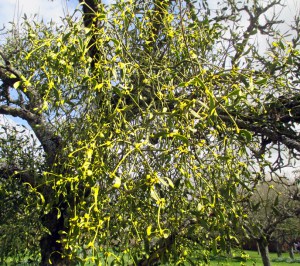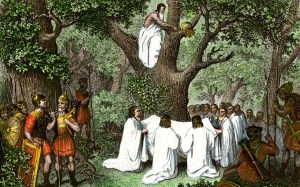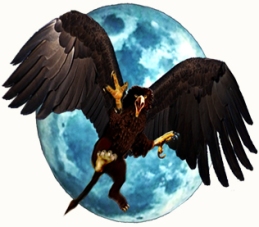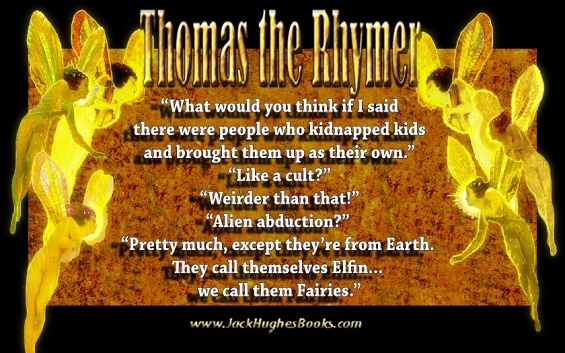The third in a series of guest posts by author Paul Andruss…

Mistletoe in Flower
It never struck me why the druids called mistletoe ‘The Golden Bough’ until I saw it in flower. The small insignificant flowers turn the whole plant dull gold in the low spring sunshine. It must have appeared magical growing from bare branches in the depth of winter suspended between earth and sky.
In popular folklore the mistletoe grows on the oak; the lightening tree – sacred to Zeus. The oak quite possibly gave the druids their name, which translates as oak-knower. But it may have come from the Celtic name for the Wren – an oracular bird revered as the Winter King- or the word ‘to see’, or indeed a combination of all three.
The ancients did not know what caused grain to ferment, i.e. the micro-organism called yeast. They believed the process was akin to the spontaneous generation of life. In much the same way rotting meat spontaneously produces maggots. However they would have been aware scrapings from the bark of the sacred oak produced fine bread and beer.
This is because the species of yeast found living on the oak is the wild ancestor of cultivated bread and beer yeasts. This may also account for the idea of the oak as a lightening tree, for it was well known lightening also spontaneously produced life – hence the role it plays in the Frankenstein movies.
In truth the mistletoe rarely grows on oaks – which must have made it all the more significant to the druids when it did. In fact the mistletoe prefers to grow on the sacred apple.
Throughout Europe the apple is steeped in myth and legend. It was believed to be the fruit eaten by Adam and Eve in Eden. The Apple of Discord caused the Trojan War. There were golden apples of immortality in the Garden of the Hesperides – a Greek myth which finds parallels in the Norse goddess Iethunn’s apples of youth and beauty; and the Irish and British paradise apple isles of Ablach and Avalon.

Legend has it the Druids harvested mistletoe with a golden sickle while holding a cloth underneath, so the sacred bough was not profaned by touching the ground. Sprigs of mistletoe were distributed to the people to hang up over doorways as a protection against lightning (the wrath of the gods?) and evil.
Despite the fact the berry juice is poisonous (so don’t try this at home folks!) the Druids called it Heal-all and used it as a remedy against poison and enchantment, and as a magical aphrodisiac to promote fertility – giving rise to the practice of kissing under it.
Mistletoe was considered the sperm of the gods because a sprig has berries that extrude a white sticky sap. (Come on people used your imagination… don’t make me spell it out.) The ancients knew man-berries (to put it bluntly) were responsible for strength, because when they were missing, as in eunuchs, males developed female characteristics such as lack of facial hair, high voices and curves in all the right places.
Ancient Roman bodybuilders used to eat bull’s testicles to build muscle. Something bodybuilders still do, but now, thankfully, they are available in tablet form.
The Romans called this masculine quality Vir – giving rise to the word virility and funnily enough virtue (valour, merit, moral perfection).
About Paul Andruss:
 Sue asked for a brief biography. I genuinely don’t know what to say.
Sue asked for a brief biography. I genuinely don’t know what to say.
If I were a musician I would be Kate Bush or the Beach Boys’ Brian Wilson; but without the mental issues or dependency on prescription drugs. For Brian not Kate! I can talk about anything except myself, so let’s talk about my work.
I’ve written 4 novels, Finn Mac Cool, and the (Harry-Potteresque) Jack Hughes Trilogy. ‘Finn Mac Cool’ and ‘Thomas the Rhymer’ are available for free download. Hint! Hint!
As with many writers, I began with no formal skills; was working long hours and could not spare family cash to pay for professional help like courses or editors. Unlike sensible people, I did not write short stories to build up my writing skills but went straight for an epic (Finn is 180,000 words). Big mistake!
Finn took 4 years to write and another 2 to realise how badly it was written. So I started learning proof-reading and editing, and started taking more notice of how other authors construct their work.
‘Thomas the Rhymer’ came about after watching a Harry Potter film. I thought I can do that! Just goes to show how wrong you can be. Damn these big ideas!
After ‘Thomas the Rhymer’, the sequels ‘Daughters of Albion’ & ‘Thirteenth Treasure’ were a lot of fun to write. I knew the characters and where I want to take them.
‘Thomas the Rhymer’ took 18 months from concept to first draft; another year to get it to agents, and 18 months with agents. It was well received by some but not taken any further.
I later learned rejection can have more to do with an agent’s belief that publishers won’t take the risk, rather than a comment on quality. Publishing is in crisis. A bit of research shows it always has been. After discovering this, I decided to go down the indie route. These days, authors have ever-expanding learning curves. Writing is just the tip of the iceberg.
Before leaving rejection letters, about which everyone can contribute! I used to take comfort from this story while crying myself to sleep.
As the author of ‘Vernon God Little’ walked away from the stage with the 2003 Booker Prize every major Literary Agency asked. ‘Why didn’t you send it to us?’
To each and every one, he replied… ‘I did!’
They had all ignored it. Yet ‘Vernon God Little’ also won the Bollinger Wodehouse Everyman Prize for Comic Fiction, the Man Booker Prize for Fiction, and the 1st Novel Award in the Whitbread Awards.
Download a free copy of Paul’s book, Thomas the Rhymer HERE

Connect with Paul:
Blog Facebook Twitter @Paul_JHBooks Google+
E-Book versions of Thomas the Rhymer are available FREE here
Learn the Story of Thomas the Rhymer
If you would like to be my guest, please read the guidelines and get in touch!









































Fascinating stuff!
LikeLiked by 1 person
Reblogged this on Die Erste Eslarner Zeitung – Aus und über Eslarn, sowie die bayerisch-tschechische Region!.
LikeLike
Thank you once more for reblogging 🙂
LikeLiked by 1 person
Thank you for the information. Have a nice weekend! Michael
LikeLike
You too, Michael 🙂
LikeLike
Isn’t it interesting how the right dose is a medicine, but the wrong one is poison? That’s true for so many things, not just mistletoe.
LikeLike
There has to be a deeper lesson than the obvious one in that.
LikeLike
Great article, and we use mistletoe nowadays as a homeopathic remedy for cancer. I love the meanings we have given to natural phenomena long before science wrote new narratives.
LikeLiked by 1 person
Yew is also providing treatment for cancer. Odd how the ancient sacred plants and trees are coming to the aid of a modern plague.
LikeLike
It’s true….perhaps they knew a thing or two our ancestors!!
LikeLike
No perhaps about it 🙂
LikeLiked by 1 person
Terrific as to be expected Paul and thanks Sue for sharing.. I have clearly been using mistletoe in the wrong way throughout my life.. no wonder unsuccessfully.. will now stick to lightning protection!
LikeLike
🙂
LikeLike
I took a holiday in Dijon, France, ooo years ago now. Thought I’d spend the day at La Source de la Seine, I’d hears there was a grotto there. I walked the last 1/2 of the way.
I’ll never forget all the wayside trees approaching the source of the River Seine, their crowns were thick with misteltoe. I’d not seen that before; amazing.
The grotto was 19th century and a little whimsical
It seemed so appropriate it was those trees.
LikeLiked by 1 person
Oddly enough, the apple orchards of Glastonbury are full of mistletoe too.
LikeLike
Reblogged this on The Feed By Our Pantheons Way.
LikeLike
Thanks, Troy.
LikeLiked by 1 person
This is fascinating. Thank you for sharing. I had noooo idea. 😛
LikeLike
🙂
LikeLiked by 1 person
😉 😉
LikeLiked by 1 person
and the word VIR is actually very interesting etymologically. there was a cognate Old English word for soldier or army – can’t quite remember which, the Irish word for man is linked and the Ossetians own name for their people. Ever thought about the ‘were’ part of werewolf?
LikeLiked by 1 person